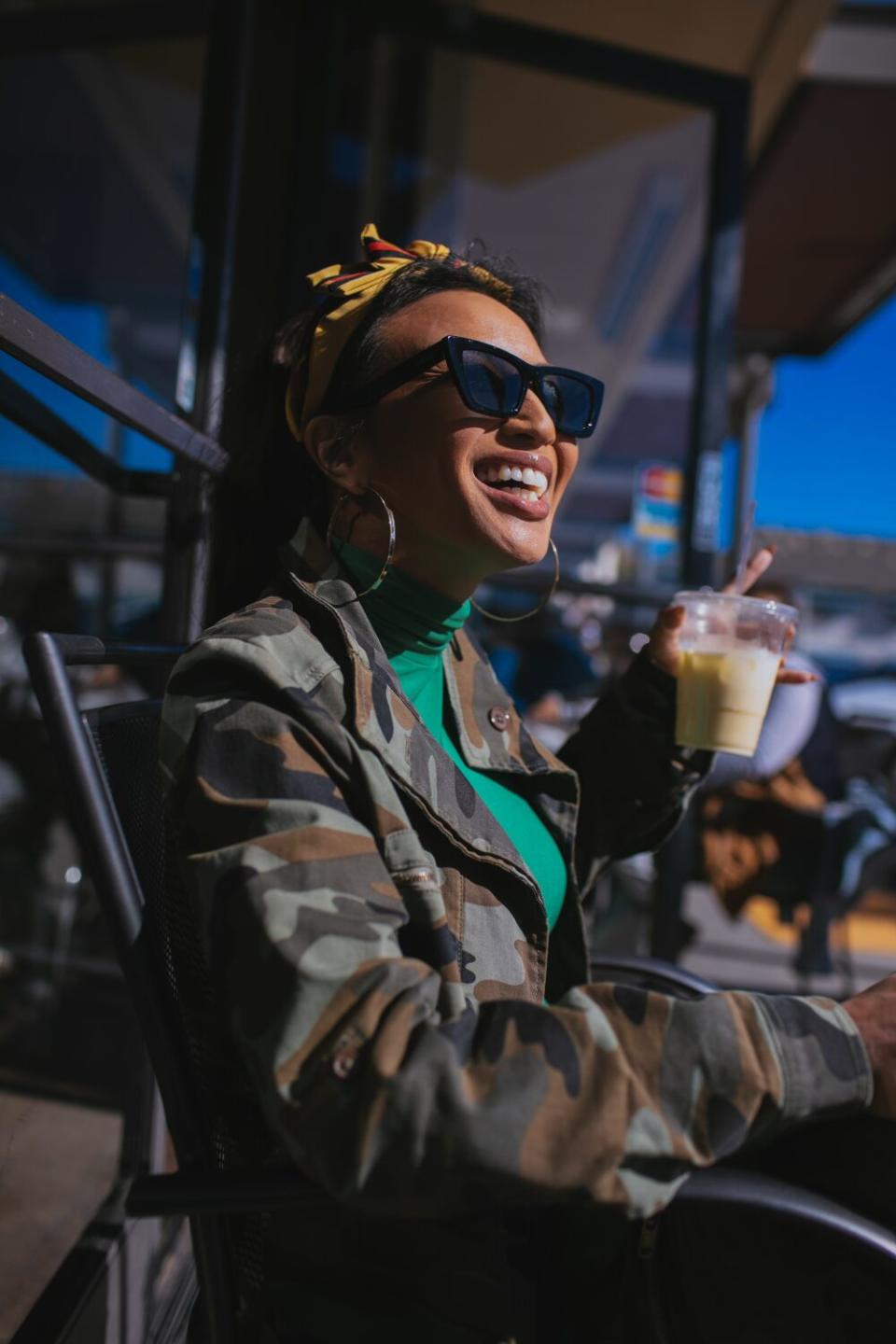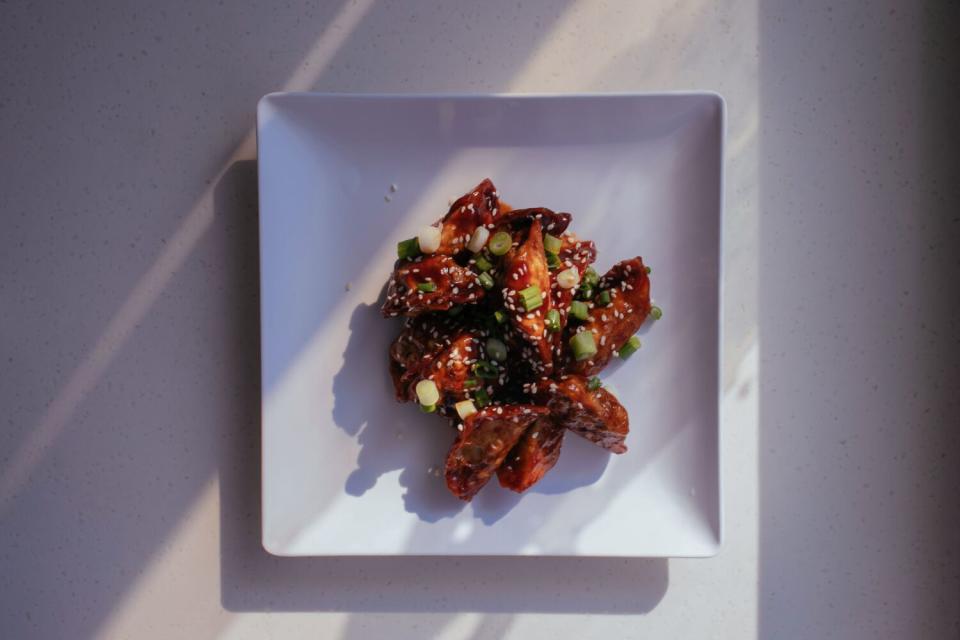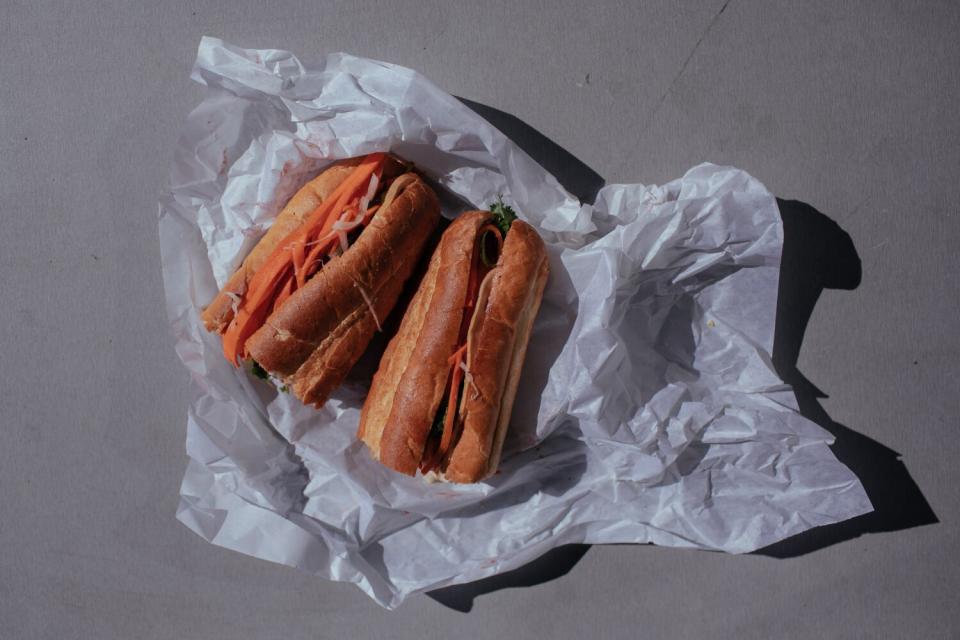How to eat pho: A Vietnamese food crawl with Jeannie Mai Jenkins

- Oops!Something went wrong.Please try again later.
Jeannie Mai Jenkins orders food like she’s giving a TED Talk, with total authority, confidence and gumption. Sitting at a table at Pho So 1, a bare-bones restaurant in a strip mall in Van Nuys, she grips the laminated menu and points excitedly to a bowl of pho.
Jenkins, best known as one of the Emmy-winning co-hosts of the daytime talk show "The Real" — which ended its eight-season run earlier this year — has made countless appearances as an energetic red-carpet fashion expert at the Golden Globes and the American Music Awards. But food, she says, is always central to what she does.
She always wanted her own food show, and recently landed her dream job hosting “America’s Test Kitchen: The Next Generation,” a cooking competition series now streaming on Amazon Freevee.
“I’ve been starving for an opportunity like this,” she says. “To actually be in the realm of food now makes me feel like a dream has finally been accomplished.”
10:37 a.m. Pho So 1
The Van Nuys branch of Pho So 1 restaurant, Jenkins' first destination on a three-stop Vietnamese food crawl, is home to her favorite bowl of pho besides her mother’s.
“When I moved to L.A.," she says, "the two homes I could afford at the time, one was 25 miles away from this restaurant and one was five miles. I picked the closer one immediately.”
In Vietnamese, Jenkins asks the server for a bowl of Dac Biet Xe Lua, a combination pho with rare slices of steak, flank, tendon, tripe and rice noodles. She wants the slices of raw beef on a plate on the side rather than served in the soup so she can control the cooking time. And she wants extra tripe in a bowl with hot broth. She would like the accompanying bean sprouts warmed so that they do not cool down the soup. And she wants a bowl of nước béo, the fat and oil they skim off the top of the soup while cooking, which they use to marinate diced green onions.
This is just the instructions for the pho.
She then points to a photo of crisp spring rolls and asks for an extra cup of nước chấm . She turns the menu over and peruses the rice dishes. Not finding exactly what she wants, she builds her own plate, requesting a charbroiled pork chop with a slice of meatloaf, shredded pork skins and a fried egg. Oh, and some extra nước chấm with that too.
Our server furiously writes in his notepad, then hurries to the kitchen.
Jenkins is the first to admit she's not a food expert. But for her, “Vietnamese food is life,” she says. Over the years, she’s made it her mission to become a sort of culinary ambassador, introducing her food and culture to everyone she encounters.

In her YouTube series, “Hello Hunnay,” pronounced so that the “nay” drags into a personality all its own, she cooks, or rather watches her mother, Olivia Tutram (a.k.a. Mama Mai), cook, and extols the virtues of Vietnamese food.
While we wait for our order, she gives me her tips for choosing a “legit” Vietnamese restaurant, tips she shared with more than 1 million viewers in a YouTube video that went viral two years ago.
“No. 1, always go with a restaurant that has a number after it," she says. “It just signifies that they go the old-school way, so you’ve got some grandmas and grandpas and some uncles in the kitchen.”
No. 2, look for a laminated menu. Then look for Vietnamese writing and lots of pictures.
“I don’t want to see ‘noodle bone broth soup.’ I want to see numbers and Vietnamese writing,” she says. “And keep your Instagram-perfect photos to yourself. I want to see uncle capturing these with his little old Canon.”
If Jenkins is particular about the way the pho is ordered, she's equally particular about how it should be eaten. She reaches for a caddy of condiments stocked with the holy trinity of pho seasoning: hoisin sauce, sambal and sriracha. She takes a small ramekin on the table and pours me some hoisin sauce, then draws a happy face with some sriracha.
After a few minutes, a parade of plates lands on the table. Jenkins immediately pulls out her phone.
“Wait, hold on,” she says. “I need to take a selfie.”
She holds her phone with an outstretched arm at a downward angle and uses her other hand to slide her high ponytail to one side. She straightens her Gucci headband and flashes a megawatt smile. Her perfectly manicured fingers snap a few photos.
“I take a selfie every time I eat because I just get so excited,” she says. “OK, now we can eat.”
Our pho bowls are crowded with slippery rice noodles, chunks of tendon and ribbons of tripe. Jenkins encourages me to try the soup before adding condiments. It’s intense and complex with that first hit of star anise in the meaty broth. I’d be happy to slurp it on its own, but she suggests a squeeze of lime, a handful of fresh herbs and a scoop of the hoisin and sriracha happy face.

Pho was a staple meal for Jenkins growing up in a three-bedroom, one-bathroom San Jose house, which was always full of brothers, aunts, uncles and grandparents. Many were relatives whom her parents sponsored for visas when the extended family — on her mother's side in the south and her father's in the north — hadn't been able to leave Vietnam on their own. f With so many relatives around, there was always something cooking on the stove.
We try the bubbly, golden fried spring rolls, lined up like logs on the plate next to lettuce leaves, fresh herbs, pickled radish and carrot. She takes a lettuce leaf and starts building a wrap with one of the rolls and some of the pickles. She adds a squeeze of sambal to her nước chấm , dunks her roll and takes a big bite.
We finish the meal with Jenkins' bespoke rice plate. In one corner sits a large pork chop atop a pile of shredded pork skins as long as noodles. Next to the skin is a slab of meatloaf. There’s a mound of rice in the middle, some pickled cabbage, sliced tomato and cucumber and two fried eggs with crisp edges. Jenkins gets to work cutting away from different components on the plate, crafting specific combinations on her spoon.
“The great, amazing thing about Vietnamese dishes is that every bite is different,” she says. “There is never a dish that tastes the same with each bite.”
12:37 p.m. Bun Me
Our next stop is Northridge's Bun Me, about 18 minutes north in another shopping center with slim parking spaces. It’s time for banh mi, a style of sandwich Jenkins ate almost daily in San Jose as a snack after school or whenever she was in need of a quick meal.
When it comes to banh mi, she has high, specific expectations. She wants a toasted baguette that’s not too hard — it should be a nice, soft cushion for the filling. The bread also needs to be slender. She does not like wide baguettes. She wants pork roll, plenty of pickled vegetables (carrots and radish), and she needs the yellow-tinted mayonnaise. (“Not from Kraft.”)
“I always get the one with everything in it,” she says.
We order the Bun Me deli special and the Special Bun Me of the month. The first is what Jenkins would consider the one with everything in it, a toasted baguette spread with mayonnaise and pâté, stuffed with slices of pork roll, a heap of barbecue pork, pickled carrot and radish sticks that spill out from the bread along with a tangle of fresh cilantro, sliced cucumber and jalapeño. The latter sandwich swaps the pâté, pork roll and barbecue for charbroiled pork.
“When I open it, I will know right away if you are the real deal,” she says. “I’m expecting real baguette bread, not something from Erewhon but a straight-up French baguette lightly toasted, spread with mayo.”
She unwraps the Bun Me deli special and starts nodding her head enthusiastically, her ponytail bobbing wildly behind her.

“OK, OK, OK, OK, OK,” she says, her excitement building with each OK. “I’m giving you, on looks so far, I’m giving it a nine.”
She goes to take a bite and then abruptly drops the sandwich.
“I forgot to take a selfie,” she says.
Click.
“That’s good,” she beams, crumbs sticking to her lip gloss. “That’s really good. I give it a 9.5 because the flavors hit, the crunch, the freshness, the tart of the pickles, and it’s super porky.”
As she finishes the first sandwich, she pops the top on a pastel-colored can she’s brought with her to lunch. It’s a boozy sparkling tea drink called Owl’s Brew, a recent addition to her growing arsenal of food and drink projects. Jenkins signed on as chief brand officer for the drink brand in February 2021.

“It’s made with natural botanicals and brewed tea," she says, "so I can drink it and not feel like I’m paying for it later.”
She digs into the charbroiled pork sandwich, nods, then offers some corrective criticism.
“It needs more acid or something tangy,” she says.
Though she says she didn’t do any food research or prep work for her hosting gig on the "ATK" show (“my passion for food was all I needed”), she does say she learned a lot on the job.
“The thing I learned from shooting 'ATK' is how much food has to have a yin and a yang, like sweet, sour, salty,” she says. “This has umami but it’s missing its yang. Maybe a little drizzle of rice vinegar.”
1:08 p.m. Vinh Loi Tofu
When we reach our final stop, Vinh Loi Tofu in Reseda, tucked into the corner of our third shopping center, owner Kevin Tran greets Jenkins with a hug and a “Hello, sister.”
Tran tells us to sit down, asks how hungry we are, then disappears into the kitchen.
Jenkins started frequenting the restaurant about five years ago. She’s more relaxed than she was at the first two stops, and she sits down without any requests or instructions.
“I usually don’t order when I come here,” Jenkins says. “Kevin knows what I like.”
As we wait for our mystery dishes, Jenkins explains what drew her to the new cooking show. The premise is 11 contestants vying to be the next cast member of “America’s Test Kitchen.” After a series of challenges, the winner earns a spot on the show, $100,000 and a cookbook deal.
With so many culinary-based competition series on the air, Jenkins believes it’s the diversity of the contestants, and the fact that she is one of the few Vietnamese American personalities on television, that set "ATK" apart.
“The first thing I noticed about 'ATK' is the diversity,” she says. “I saw so many different types of people and stories and cultures that I haven’t seen on a cooking show before. Representation is so important when it comes to sharing your cuisine so that when people think of American staples, they think of tamales, banh mi and pho and so many other things.”

Tran emerges from the kitchen carrying a steaming bowl of soup he simply calls “Kevin No. 1.” Squares of tofu bob around in the broth alongside sliced mushrooms and bean sprouts.
“I get this every time,” she says. “It’s all your favorite things about Vietnamese food in one soup and you can only get it through him.”
It’s a take on one of her favorite dishes, bún riêu, a seafood soup typically made with tomato and crab. Tran’s broth tastes similar to a classic tom yum soup, with a salty, sour backbone and lots of citrus.
Then Tran brings out a plate of deep-fried vegetable dumplings smothered in a sweet barbecue sauce; a plate overflowing with a mixture of stir-fried noodles and rice that he says is one of Jenkins’ brother’s favorites; spring rolls filled with tofu; and a plate of cold vermicelli noodles dressed with sliced tempeh and a plant-based nước chấm-like dressing made with a sweet canned coconut drink, soy sauce and sambal.

Click. Jenkins takes her obligatory selfie, then reaches for a spoon.
“I guess we’re not going to need dessert,” she says with a laugh.
We didn’t.

This story originally appeared in Los Angeles Times.

